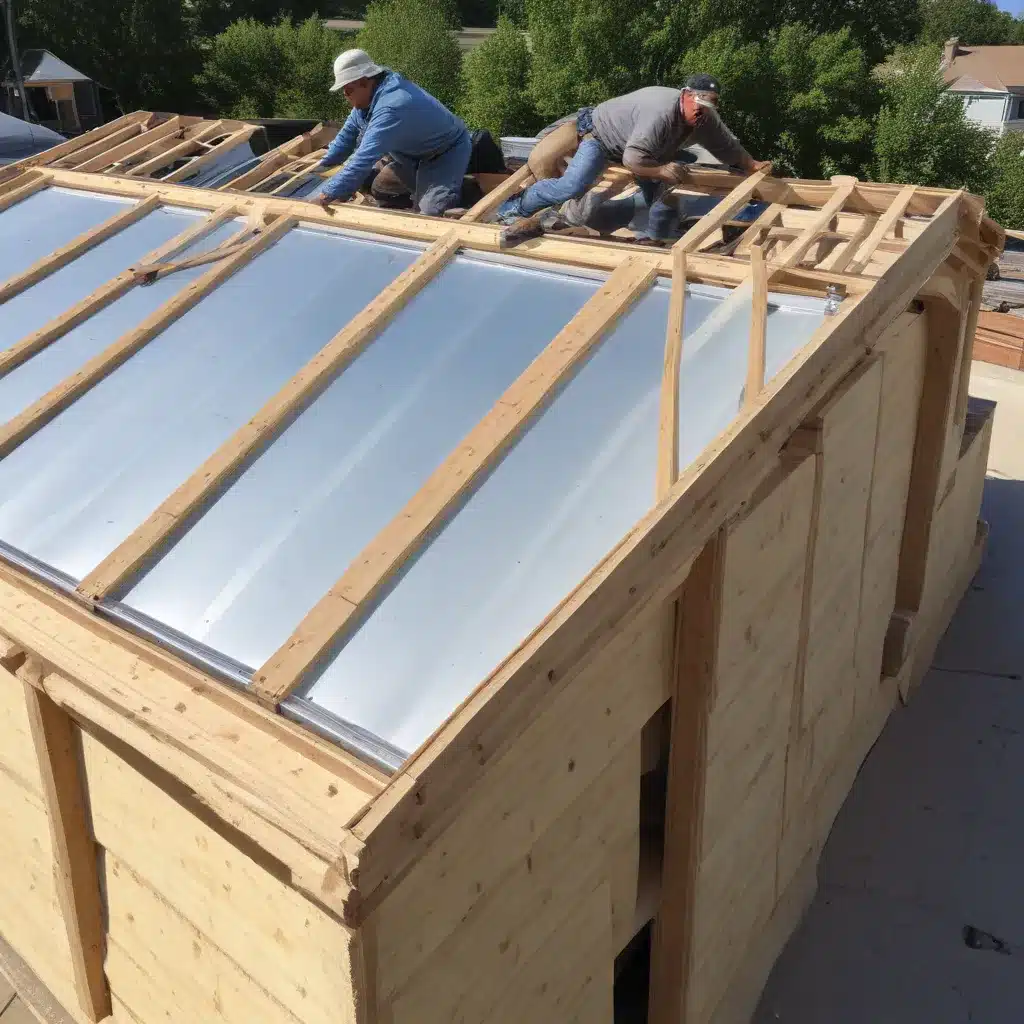
Understanding the Benefits of SIPs in Roofing
As a seasoned roofing professional, I’ve seen firsthand the profound impact that innovative building materials can have on improving the energy efficiency and sustainability of residential and commercial structures. One such technology that has been steadily gaining traction in the roofing industry is Structural Insulated Panels (SIPs).
SIPs are high-performance building systems composed of an insulating foam core sandwiched between two structural facings, typically oriented strand board (OSB). These prefabricated panels offer a range of advantages that make them an increasingly attractive option for modern roofing applications.
Energy Efficiency: One of the primary benefits of SIPs is their exceptional insulating properties. Compared to traditional framing methods, SIPs can be up to 50% more energy-efficient, providing a continuous thermal envelope that minimizes heat transfer and air infiltration. This translates to significant reductions in heating and cooling costs for building owners over the lifetime of the structure.
Airtightness and Indoor Air Quality: The seamless construction of a SIP roof system creates an exceptionally airtight building envelope, limiting the intrusion of outdoor pollutants, allergens, and moisture. This not only enhances the comfort and indoor air quality for occupants but also helps prevent the formation of mold, mildew, and other moisture-related issues that can compromise the structural integrity of the roof.
Sustainability and Reduced Environmental Impact: SIPs are a sustainable building product, with a lower embodied energy and carbon footprint than traditional construction materials like steel, concrete, and masonry. Additionally, the manufacturing process for SIPs generates significantly less waste compared to stick-frame construction, contributing to a more environmentally responsible roofing solution.
Designing with SIPs: Flexibility and Efficiency
One of the key advantages of incorporating SIPs into roofing systems is the design flexibility they offer. These prefabricated panels can be engineered and customized to suit a wide range of architectural styles and building geometries, allowing architects and homeowners to explore creative design possibilities while maintaining optimal performance.
Rapid and Precise Installation: SIPs are designed and manufactured off-site, which enables a streamlined and efficient installation process. The panels can be quickly assembled on-site, reducing construction timelines and associated labor costs. Additionally, the precision-cut panels minimize the need for on-site cutting and trimming, further enhancing the speed and accuracy of the installation.
Structural Integrity and Durability: The sandwich-like construction of SIPs, with their rigid foam core and structural facing materials, provides exceptional strength and load-bearing capacities. This makes them well-suited for roofing applications, where they can withstand the demands of various environmental conditions, such as heavy snowloads, high winds, and seismic activity.
Improved Thermal Performance: The continuous insulation provided by SIPs helps to eliminate the thermal bridging that is often seen in traditional framing methods, where studs, joists, and other structural members can compromise the overall thermal efficiency of the roofing system. This enhanced thermal performance not only reduces energy consumption but also contributes to improved occupant comfort and a more consistent indoor temperature throughout the year.
Navigating the SIP Roofing Installation Process
While the benefits of SIPs in roofing are well-established, it’s important to understand the nuances of their installation and maintenance to ensure optimal performance and longevity.
Proper Site Preparation and Handling: Before the installation of SIP roof panels, it’s crucial to ensure the supporting structure is level, plumb, and capable of withstanding the weight and loads of the system. Proper handling and storage of the panels during the construction process are also essential to prevent damage and maintain their structural integrity.
Airtight Sealing and Detailing: To maximize the energy-saving potential of a SIP roofing system, it’s critical to pay close attention to the sealing of all joints, edges, and penetrations. Careful application of sealants, gaskets, and tapes is necessary to create a continuous, airtight envelope that prevents air leakage and minimizes the risk of moisture-related issues.
Ventilation and Moisture Management: Due to the exceptional airtightness of SIP roofing systems, it’s important to incorporate a well-designed ventilation strategy to maintain indoor air quality and prevent the buildup of moisture within the assembly. This may involve the use of mechanical ventilation systems or strategically placed vents and openings to ensure proper air circulation and moisture control.
Ongoing Maintenance and Inspections: Like any roofing system, SIPs require regular maintenance and inspections to identify and address any potential issues, such as damage to the facing materials, compromised seals, or signs of moisture intrusion. Adhering to the manufacturer’s recommended maintenance protocols and promptly addressing any concerns can help ensure the long-term performance and durability of the roofing system.
Exploring the Future of SIPs in Roofing
As the demand for energy-efficient and sustainable building solutions continues to grow, the role of SIPs in roofing is poised to become increasingly prominent. Manufacturers are continually innovating and improving the design and performance of these high-tech panels, offering ever-greater levels of thermal efficiency, structural integrity, and design flexibility.
One exciting development in the SIP roofing landscape is the integration of renewable energy technologies, such as photovoltaic (PV) panels. By seamlessly incorporating PV systems into the SIP panels, building owners can further enhance the energy efficiency and environmental benefits of their roofing systems, generating their own clean, renewable power.
As a roofing professional, I’m enthusiastic about the potential of SIPs to transform the way we approach residential and commercial roofing projects. By embracing these innovative building materials, we can not only deliver superior energy performance and indoor comfort but also contribute to a more sustainable built environment for generations to come.
To learn more about the latest advancements in SIP roofing technology and how it can benefit your next project, I encourage you to visit https://www.roofersinnorthampton.co.uk/. Our experienced team is always eager to share our expertise and guide you towards the most effective roofing solutions for your needs.

